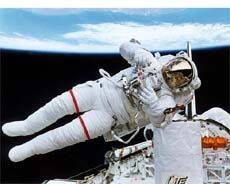Astronauts don’t talk much about it, but about half of those who fly in space experience Space Adaptation Syndrome (SAS), or space sickness, which includes nausea, vertigo, visual illusions and headaches. Even though SAS isn’t life threatening, the onset of these symptoms at a crucial point in the mission could have potentially detrimental affects. The last thing any space flight needs is a violently ill commander or pilot during important maneuvers like docking to the space station, or a spacewalker doing the Technicolor Yawn in his helmet. Researchers have determined that SAS is not caused so much by the weightlessness experienced in space, but more by the body adapting to a different gravitational force. A Dutch PhD student studying SAS believes she may have developed a ground-based method for identifying people who are subject to space sickness, following her research in which she whirled test subjects around in a centrifuge.
Until now, no one could determine which astronauts would experience SAS. It can strike seasoned fighter-pilots-turned-astronauts who would claim to be immune from motion sickness, and additionally frequent flyer astronauts can experience SAS on one mission, but not another, while some rookie astronauts are symptom-free.
But Suzanne Nooij says her research shows that an astronaut who will suffer space sickness in microgravity conditions will also suffer it after being vigorously centrifuged at 3G for an hour or so. Spinning at that force is somewhat easily endured for that amount of time, but Nooij says, if you’re susceptible to SAS, once you get out of the centrifuge you’ll puke.
Nooij focused her research on the organ of balance, the area in the inner ear made of semi-circular canals, which are sensitive to rotation, and “otoliths,” saccules inside the ear which are sensitive to linear acceleration. Previous research suggests that a difference between the functioning of the left and right otolith contributes to susceptibility to sickness among astronauts. If this is the case, this should also apply after lengthy rotation.
Nooij tested this otolith asymmetry hypothesis. The otolith and semi-circular canals functions on both sides were measured of fifteen test subjects known to be susceptible to space sickness. Those who suffered from space sickness following rotation proved to have high otolith asymmetry and more sensitive otolith and canal systems. These people could not be classified as sensitive or non-sensitive on the basis of this asymmetry alone, but could on the basis of a combination of various otolith and canal features. This demonstrates that the entire organ of balance is involved in space sickness and that it probably entails complex interactions between the various parts of the organ of balance.
While researchers have yet to find a cure for this, previous knowledge of a space flyer’s susceptibility to SAS would allow for preventative measures such as taking motion sickness medicine, limiting food intake, and avoiding quick head movements.
While Nooij is not an astronaut, her PhD supervisor at TU Delft, is Wubbo Ockels, the first Dutchman in space in 1986, who suffered from SAS.
Original News Sources: Physorg, The Register


Nice article Nancy! Gives a really nice insight to the reality of humans in space. I’ve often wondered if space flight would feel like a Sunday moning!
Cheers, Ian 😉
Nice title! Barfing in your helmet does not sound like it would make for a great spacewalk. I also remember hearing somewhere that the weightlessness has an effect on the digestion of food in astronauts’ stomachs (as peristalsis relies partly – though not entirely – on gravity), causing some other ill effects. Of course, maybe it’s just the food itself that causes a “colorful reaction.” 🙂
When we as a civilization begin genetically modifying our offspring, this seems like it will be near the top of the list.
This certainly appeals to the kid in me! Simply thinking abot a highly trained individual violently splurging in their helmet made me giggle.
(See the opening sequence of 80’s UK flop comedy film ‘Morons from Outer Space’). Nice article.
I wonder if sick smells in zero G
After reading through the article, I feel that I need more information on the topic. Can you suggest some resources ?